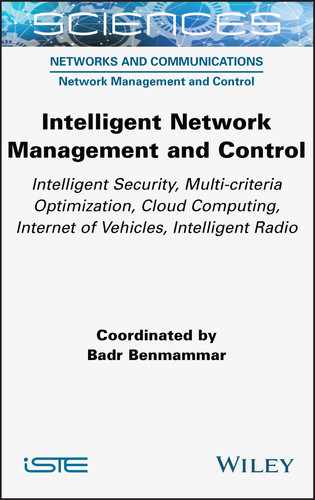The management and control of networks can no longer be envisaged without the introduction of artificial intelligence at all stages. Intelligent Network Management and Control deals with topical issues related mainly to intelligent security of computer networks, deployment of security services in SDN (software-defined networking), optimization of networks using artificial intelligence techniques and multi-criteria optimization methods for selecting networks in a heterogeneous environment. This book also focuses on selecting cloud computing services, intelligent unloading of calculations in the context of mobile cloud computing, intelligent resource management in a smart grid-cloud system for better energy efficiency, new architectures for the Internet of Vehicles (IoV), the application of artificial intelligence in cognitive radio networks and intelligent radio input to meet the on-road communication needs of autonomous vehicles.
Table of Contents
- Cover
- Title Page
- Copyright
- Introduction
- PART 1: AI and Network Security
- 1 Intelligent Security of Computer Networks
- 1.1. Introduction
- 1.2. AI in the service of cybersecurity
- 1.3. AI applied to intrusion detection
- 1.4. AI misuse
- 1.5. Conclusion
- 1.6. References
- 2 An Intelligent Control Plane for Security Services Deployment in SDN-based Networks
- 2.1. Introduction
- 2.2. Software-defined networking
- 2.3. Security in SDN-based networks
- 2.4. Intelligence in SDN-based networks
- 2.5. AI contribution to security
- 2.6. AI contribution to security in SDN-based networks
- 2.7. Deployment of an intrusion prevention service
- 2.8. Stakes
- 2.9. Conclusion
- 2.10. References
- PART 2: AI and Network Optimization
- 3 Network Optimization using Artificial Intelligence Techniques
- 3.1. Introduction
- 3.2. Artificial intelligence
- 3.3. Network optimization
- 3.4. Network application of AI
- 3.5. Conclusion
- 3.6. References
- 4 Multicriteria Optimization Methods for Network Selection in a Heterogeneous Environment
- 4.1. Introduction
- 4.2. Multicriteria optimization and network selection
- 4.3. “Modified-SAW” for network selection in a heterogeneous environment
- 4.4. Conclusion
- 4.5. References
- PART 3: AI and the Cloud Approach
- 5 Selection of Cloud Computing Services: Contribution of Intelligent Methods
- 5.1. Introduction
- 5.2. Scientific and technical prerequisites
- 5.3. Similar works
- 5.4. Surveyed works
- 5.5. Conclusion
- 5.6. References
- 6 Intelligent Computation Offloading in the Context of Mobile Cloud Computing
- 6.1. Introduction
- 6.2. Basic definitions
- 6.3. MCC architecture
- 6.4. Offloading decision
- 6.5. AI-based solutions
- 6.6. Conclusion
- 6.7. References
- PART 4: AI and New Communication Architectures
- 7 Intelligent Management of Resources in a Smart Grid-Cloud for Better Energy Efficiency
- 7.1. Introduction
- 7.2. Smart grid and cloud data center: fundamental concepts and architecture
- 7.3. State-of-the-art on the energy efficiency techniques of cloud data centers
- 7.4. State-of-the-art on the decision-aiding techniques in a smart grid-cloud system
- 7.5. Conclusion
- 7.6. References
- 8 Toward New Intelligent Architectures for the Internet of Vehicles
- 8.1. Introduction
- 8.2. Internet of Vehicles
- 8.3. IoV architectures proposed in the literature
- 8.4. Our proposal of intelligent IoV architecture
- 8.5. Stakes
- 8.6. Conclusion
- 8.7. References
- PART 5: Intelligent Radio Communications
- 9 Artificial Intelligence Application to Cognitive Radio Networks
- 9.1. Introduction
- 9.2. Cognitive radio
- 9.3. Application of AI in CR
- 9.4. Categorization and use of techniques in CR
- 9.5. Conclusion
- 9.6. References
- 10 Cognitive Radio Contribution to Meeting Vehicular Communication Needs of Autonomous Vehicles
- 10.1. Introduction
- 10.2. Autonomous vehicles
- 10.3. Connected vehicle
- 10.4. Communication architectures
- 10.5. Contribution of CR to vehicular networks
- 10.6. SERENA project: self-adaptive selection of radio access technologies using CR
- 10.7. Conclusion
- 10.8. References
- List of Authors
- Index
- End User License Agreement
